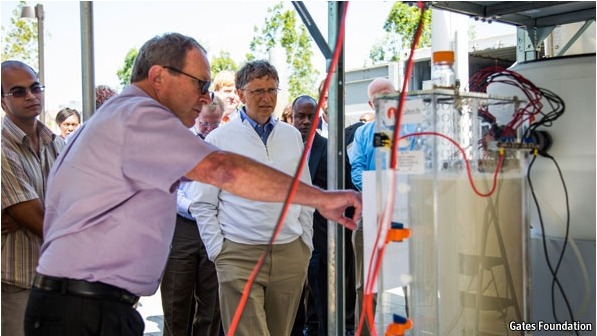
"IF Thomas Crapper were around today, he would find our toilets quite familiar," says Bill Gates, referring to the Victorian manufacturer of sanitary ware whose name has become attached to one of the body's most fundamental functions. "They haven't seen many advances apart from handles and paper toilet rolls." In fact, with the exception of S-traps to contain odours, flush toilets have changed little since Sir John Harington installed one in Richmond Palace for Queen Elizabeth I.
比尔盖茨提起卫生洁具制造商维多利亚时说道:"如果今天汤马斯·克拉普在这里,他一定会发现我们的马桶很熟悉。"一谈起维多利亚时代汤马斯·克拉普这个名字,就很容易联想到身体的最基本功能之一。比尔盖茨还谈到:"与汤马斯·克拉普时代相比,这些马桶除了在把手和厕纸卷筒上有所改进,其他并没有太多改进。"事实上,除了应用s形下水管存水弯存储臭气,抽水马桶自约翰·哈灵顿爵士为女王伊丽莎白一世在里士满宫安装了抽水马桶起几乎未发生改变。
Mr Gates considers it time for a change. On August 14th his charitable institution, the Bill & Melinda Gates Foundation, announced the gold-, silver- and bronze-medal winners in its Reinvent The Toilet Challenge, which aims to bring safe, affordable and "sustainable" loos to the 40% of the world's population who lack access to basic sanitation, thus preventing many of the 1.5m childhood deaths from diarrhoea that now occur each year.
盖茨先生认为现在是时候做一些改变了。8月14日,他的慈善机构--比尔与梅琳达.盖茨基金会宣布举行彻底改造马桶挑战的活动,并设立金牌、银牌、铜牌的奖项。该活动意在为世界40%缺乏基本卫生设备的人口提供安全、实惠、耐用的厕所。现今,每年因腹泻死亡的儿童人数为150万。而这样的举措能防止很多这样的孩子死亡。
The Challenge is nothing if not ambitious. It seeks a toilet that costs less than five cents per user per day to operate, that requires neither a supply of clean water nor sewerage infrastructure to take the waste away, and that will generate energy and recover salts, water and other nutrients. Remarkably, despite the challenge being little more than a year old, the award winners claim to be on track to achieve all of these goals.
这样的挑战是极其雄心勃勃的。它致力于建造一个每天每次不超过5分的厕所。这样的厕所不依靠清洁的水也不依靠排水设备来排污,在产生能量的同时还能提取盐分、水分和其他营养物质。更引人注目的是,这项挑战在一年内就完成了,而且奖项的获得者都如之前所定的那样达到了所有的目标。
In third place is a toilet designed by researchers at the University of Toronto. This treats urine and faeces separately, using a material freely available in many of the world's poorest regions: sand. Urine is filtered through sand, and the resulting liquor is exposed to ultraviolet light to sterilise it. Faeces are dried slowly within the toilet before being fed into a smouldering sand-filled reactor. The system can sanitise the waste of ten people in two hours, leaving only sand and fresh(ish) water behind.
位列第三名的厕所设计者为多伦多大学的研究员们。该厕所将尿液和排泄物分开处理。所使用的材料即使很多最贫穷的地区也能大量的获得,这种材料就是沙子。尿液经过沙子过滤,所产生的液体再经过紫外线杀菌。排泄物则在厕所里慢慢的变干,填充进一个装满沙子的低温干馏反应器。这个系统能在两个小时内给十个人的排泄物进行卫生处理,最后只留下沙子和干净的水。
The runner-up, from Loughborough University in Britain, brings chemical-engineering principles to bear. A tank feeds mixed urine and faeces through a rig that heats it to 200°C under high pressure, killing pathogens. Returning the superheated mixture suddenly to atmospheric pressure causes it to separate into its liquid and gaseous components. The gas is used to heat the feed tank. The liquid is fed into a digester that produces enough methane to power the entire system—and some to spare.
亚军来自英国的拉夫堡大学,他们应用的是化学工程原理。尿液和排泄物都存储在一个容器中,在高压下利用一个仪器将它加热到200°C,这样就能杀死致病菌。将高温处理的混合物迅速置于大气压下,使之分离成液体和气态颗粒。气体用来加热最初的供给容器,而液体则加入蒸炼器中产生的沼气除了足够为整个系统供能外,还有剩余。
The winning toilet, however, is smarter still. It has been developed by Michael Hoffman of the California Institute of Technology, and has earned him the $100,000 first prize. Dr Hoffman's toilet uses solar panels to power an electrochemical system that produces two things. One is hydrogen. The other is a compound which oxidises the salts in urine to generate chlorine. This creates a mildly disinfecting solution that can be used to flush the toilet. The hydrogen is suitable for cooking or for powering a fuel cell to produce electricity. The solid residue from the process can be employed as fertiliser.
冠军厕所也更为智能。它是由加州理工学院的迈克尔·霍夫曼开发的,并未它的开发者赚入了10万美元的一等奖奖金。霍夫曼博士的厕所是由太阳能电池板为一个电化学系统供能的。这样一来会产生两种物质:一种是氢气,另一种是化合物能氧化尿液中的盐分,产生氯。它能产生一种温和的消毒液来冲洗厕所。而氢气则能够被用来烹饪或给燃料电池充电产生电能。而整个过程产生的固体残渣则可以用做化肥。
The Gates Foundation will now pay for prototypes to be tested in the field, probably of all three winners and possibly of some other ideas, and Mr Gates hopes that the foundation's reinvented toilets will start being deployed for real in as little as two years. They will thus be able to contribute to achieving what is the most off-track of the United Nations' Millennium Development Goals, to halve by 2015 the proportion of people without sustainable access to basic sanitation. As the chairman of the UN Secretary-General's Advisory Board on Water and Sanitation, the Prince of Orange, observes, "politicians and leaders worldwide don't like to be associated with toilets, even state-of-the-art toilets. This sanitation stigma distorts international and national development agendas."
现在,盖茨的基金会就会为这些技术雏形付以报酬来进行该领域的试验,这些技术雏形有可能是前三甲,也有可能是其他的设计。盖茨先生希望由基金会彻底改造的厕所会在两年内正式投产。他们也能因此为联合国千年发展目标做出最不寻常(最离经叛道?)的贡献,在2015年使不能持续享受基本卫生设备的人口减少一半。联合国秘书长顾问委员会水与卫生部主席奥伦治公评价道:"全世界的政治家和领导人并不愿意让自己和厕所联系在一起,即使是最先进的厕所。正是这样一种关于卫生的特性让国际和国家的发展计划都产生了扭曲。"
Dr Hoffman agrees that sanitation is insufficiently sexy. He says the technology behind his winning solar-powered toilet had been sitting on the shelf since he demonstrated it to NASA, America's space agency, in the early 1990s, for use on the International Space Station. "It is," as he puts it, "hard to get a scientific grant for treating faeces."
霍夫曼博士也认为卫生事业不是那么吸引人。他表示,他曾于1990年初将他的太阳能供能厕所向美国宇航局,美国国家航空和宇宙航行局进行展示以供他们在国际空间站中使用,但是这样的技术之后就被搁置了。他表示:"要在处理排泄物上得到科学基金是很难的。"
Even the Gates Foundation itself, which hands out around $3 billion each year, has so far devoted just $6.5m to its Reinventing The Toilet Challenge. But that will change as the project goes from conception to delivery. The foundation now intends to spend up to $80m a year on sanitation, an investment that the World Health Organisation estimates will produce a return of 900% in the form of social and economic benefits coming from increased productivity and reduced health care costs.
即使是盖茨基金会本身至今也尽投入了650万美元用于彻底改造厕所的挑战,而基金会每年的慈善基金花费在30亿元左右。但是这个项目从一个观念到实际交付,这样的的情况就会改观。当前,该基金会意欲每年在卫生上的投资加大至八千万美元。投资后,预计国际卫生组织会在社会和经济效益方面获得9倍的收益,不仅它的生产能力会提高,它的卫生保健成本也会下降。












